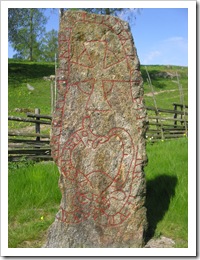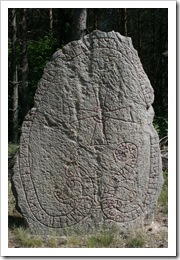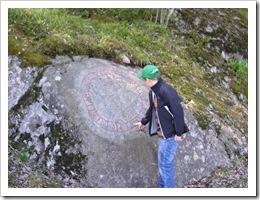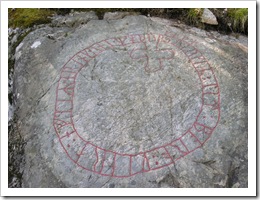Totally Off Topic - Swedish Rune Stones From the Viking Age
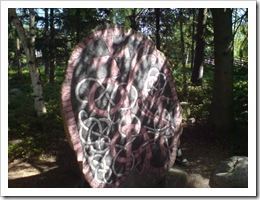 This is totally off topic from the things I usually write about, but I thought I might show some pictures of a few beautiful rune stones we have scattered around not far from where we live (Botkyrka, southern part of Stockholm, Sweden) and tell you something about this particular type of landmark the Vikings left us. My knowledge of rune stones and runic inscriptions are minimal and I may get some info slightly wrong here, so bear with me :) I'm sure Wikipedia got tons of info on the topic if you hunger for more.
This is totally off topic from the things I usually write about, but I thought I might show some pictures of a few beautiful rune stones we have scattered around not far from where we live (Botkyrka, southern part of Stockholm, Sweden) and tell you something about this particular type of landmark the Vikings left us. My knowledge of rune stones and runic inscriptions are minimal and I may get some info slightly wrong here, so bear with me :) I'm sure Wikipedia got tons of info on the topic if you hunger for more.
The typical rune stone is a raised stone with runic inscriptions on it, but it also happens that you run across runes inscribed on bedrocks. It seems that the main purpose of these stones where to mark important events, explain inheritance, boast about the construction of a bridge or a road and very often to bring glory to kinsmen who travelled far and (quite often) died in foreign lands. Most rune stones are located in Scandinavia (Sweden, Norway, Denmark, Iceland), but there are also a few in locations where the Scandinavians of that time (mostly Norsemen) went, like England, Greenland and Ireland.
What's so cool is that most of these stones were carved and erected during the Viking Age (from around year 790 to 1100), and thousands of these stones still stand where they were erected more than a thousand years ago. Some stones have been moved from where they were first found to a place close nearby where they are more accessible to folks who are interested in them. Through the years stones have been destroyed by construction, stolen by collectors and damaged by air pollution but still there are over 6.000 registered rune stones or fragments of them around, most of them (over 3.000) are located in Sweden, and most of those in the province of Uppland on the eastern coast of Sweden, just north of Stockholm.
In Sweden, most of the stones are kept in a healthy state and looked after by a state organization. These people remove lichen and sometimes paint the runes with red paint, which is believed to be the most common color used. There are stories of runes being reddened by blood, but that's probably just that - stories. The rune stone above to the right is called "Ölsastenen", found in Uppland but moved to Skansen, an open air museum and zoo located in the middle of Stockholm. It is painted in (probably) authentic manner. That picture I took with my mobile camera, so the quality is quite bad.
If you ever visit Stockholm and want to see a few rune stones, Skansen is probably the easiest place to go.
The alphabet used on most of stones around where we live is the one called The Younger Futhark which consists of 16 characters:

Some experts are so skilled in this language, they can read it right off the stones if the runes are clear enough to read. What may be interesting to know is that the English language borrowed hundreds of words from the language spoken by the Vikings of this age, Old Norse. The Scandinavian words were introduced during the Viking invasion of England in the 9th and 10th century. It's easy to recognize some of the words written on the rune stones in both the English and Swedish language. For example, the Viking word faþur, means father which is fader in Swedish. There are many, many other examples of old, basic words which are similar in English and Swedish. Now, I think that Old English and Old Norse were derived from the same Germanic language, so it may be that the word father came from there, but it's still cool. I've read somewhere that Scandinavian "businessmen" visiting the British islands could make themselves understood quite well, even without screaming and raised swords...
Most of the rune stones in the Uppland area have a Christian cross carved into them, showing they were of the Christian faith or supported a Christian king.
This picture I took with a somewhat better camera and show the stone at Hamra (Sö 289). It reads "Björn and Holm--- erected this stone after Kättilbjörn, their --- God help the soul". Some carvings cannot be clearly read as you can see.
This is the stone at Uringe (Sö 298) and reads "Håur and Karl and Sighjälm and Vihjälm and Kåre erected this stone after Vigmar, their father". How nice of them! The stone is over 1000 years old.
To get an understanding of the size of some of these stones, here's a picture of the stone at Uttran (Sö 305) and myself. The picture is taken by my son Pontus and a rune stone excursion we did earlier this summer. This stone was erected by two brothers and reads "Sibbe and Tjarve erected this stone after Torkel their father".
The pictures above show the bedrock carvings in Glömsta (Sö 300), just 5 minutes from where we live. This rune stone is a bit special because it's dedicated to a mother: "Sverker built the bridge after Ärengunn, his good mother". The bridge Sverker mentions is probably not a bridge over water, but rather improvement of the (what is believed to be an important) road that passed by this very place. So to honor his mother, perhaps he inherited lands from her, Sverker had this road improved and let everyone that used it read about this. 1000 years ago. I know, it's not like wall paintings in pyramids, but still cool.
